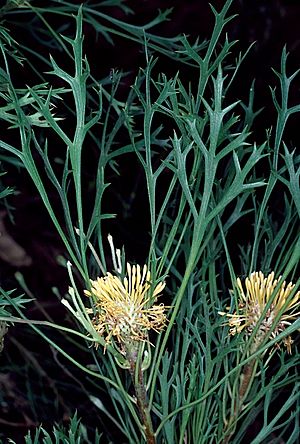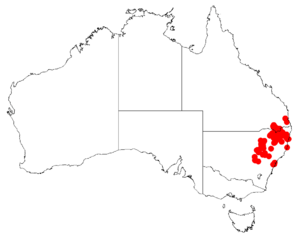Isopogon petiolaris facts for kids
Quick facts for kids Isopogon petiolaris |
|
|---|---|
 |
|
| In the Australian National Botanic Gardens | |
| Scientific classification | |
| Genus: |
Isopogon
|
| Species: |
petiolaris
|
 |
|
| Occurrence data from Australasian Virtual Herbarium | |
| Synonyms | |
|
|
Isopogon petiolaris is a special plant found only in eastern Australia. It's a type of shrub that grows low to the ground and spreads out. You can easily spot it by its interesting leaves, which are divided and have sharp points. It also has pretty, round heads of yellow flowers. This plant belongs to the Proteaceae family.
Contents
About the Isopogon Plant
What Does It Look Like?
The Isopogon petiolaris is a low, spreading shrub. It usually grows less than 1 meter (about 3 feet) tall. Its branches are a reddish-brown color.
Its leaves are quite unique. They are usually 90 to 150 millimeters (about 3.5 to 6 inches) long. The leaves are divided into many parts, like a feather or into three main sections. These divided parts are sharply pointed.
The flowers grow in round clusters, about 15 to 20 millimeters (0.6 to 0.8 inches) wide. These flower heads are surrounded by special leaves called involucral bracts. The flowers themselves are yellow and about 8 to 10 millimeters (0.3 to 0.4 inches) long. They are mostly smooth, without hairs.
When Does It Flower?
You can see this plant flowering from July to November. After the flowers, it produces a hairy fruit called a nut. These nuts are fused together in a round or oval head, about 12 to 16 millimeters (0.5 to 0.6 inches) wide.
How Was It Named?
The Isopogon petiolaris was first officially described in 1830. A botanist named Robert Brown gave it its formal name. He wrote about it in his book, Supplementum. The plant samples he studied were collected in 1827 near Moreton Bay by another botanist, Allan Cunningham.
Where Does It Grow?
This plant mostly grows in rocky areas. You can find it in forests and heathlands. It lives in south-eastern Queensland, especially around the Darling Downs. It also grows south through the Northern Tablelands in New South Wales, all the way to near Parramatta. You can even find it west to the Pilliga forest and Parkes.

